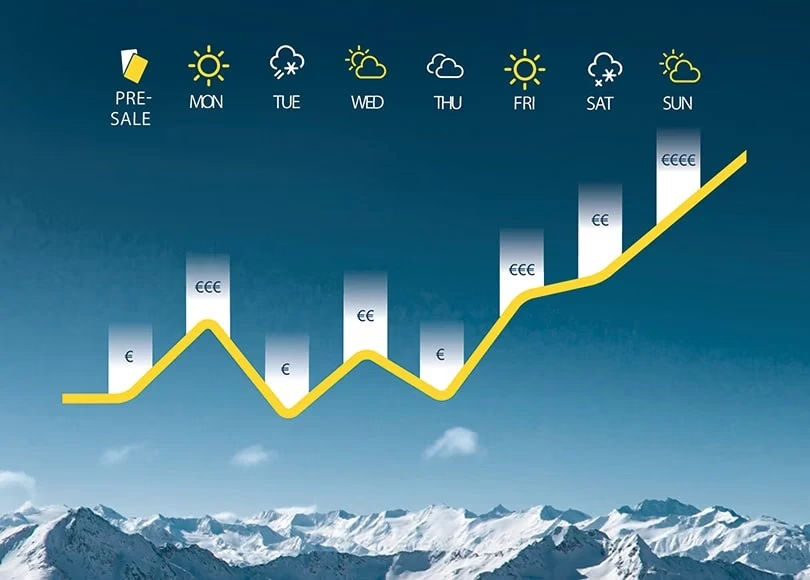As in previous years, ski ticket prices for winter 2024/25 have again risen noticeably - although usually not by ten percent as recently. But are there ways to ease the price pain?

The new "magic solution" is called dynamic pricing, which means the end of price lists in the usual form. The system is familiar from the hotel and airline sectors, with prices varying depending on the distance to the ticket start date and the expected occupancy. It mainly involves the following two things: How do I pass the weather risk on to my guests? How can I react more flexibly to fluctuations in demand?
In Switzerland, the dynamic pricing system is already very widespread. There are also studies there that show that the measure does not generally harm the lift operators. Isabella Dschulnigg-Geissler, Managing Director of the cable cars in Saalbach, sees things differently: “What we all see as
Dynamic pricing is almost always just early bird discounts. When I compare our figures with regions that have been doing this for a long time, I cannot see any advantage in their added value." Dschulnigg does not want to rule out the possibility that Saalbach could switch to more flexible pricing models "at some point", but: "Today we have enough craziness in the world. We want to give guests the security that they will pay what is on the list." In theory, cable cars benefit from more even occupancy, but also from higher prices when demand is high. This means that tickets are most expensive everywhere during holiday periods anyway. And who really travels in sleet and fog just because it is 20 percent cheaper? Cable car chairman Franz Hörl is skeptical about dynamic pricing, but the decision lies with the individual companies.
ALL JUST TO INCREASE PROFITS? It is certainly not the case that the consumer does not benefit from it. With the online ticket in their pocket, the guest can confidently walk past the queue in the morning - which may not be as long in the future. Ideally, they have downloaded the ticket onto their mobile phone, as is offered by KitzSki, for example - which is once again offering fixed prices. With others, the ticket must be loaded onto an old data storage device at the machine. However, there are other limitations to the advantages. The guest assumes the risk, because the logic of the system - those who book earlier pay less - means that the unused ticket cannot be returned. However, Ski amadé has found an innovative solution here. Those who pay €2.50 more per day and person get a cancellation guarantee. With the others, the weather risk remains with the skier. When it storms and snows, you have to grit your chattering teeth with the cheap ticket.
CHEAPER ADVANCE SALE PRICES really do exist, as a test by Ski Guide Austria, now repeated for the third time, shows. We always booked in the 42nd calendar week for the Christmas week. Silvretta Montafon showed a price increase of three percent in 2024 compared to the previous year, which was well below the industry average. We are interested in the values disclosed in 2023 from the Ötztal. At that time, in Sölden, at EUR 68,- online, you could get within EUR 1.50 of the maximum cash register price. The current test purchase showed a noticeable increase for Sölden in December 2024 at EUR 68.50 to 78.50. For February 2025, the price is EUR 75.50, while day tickets for the end of April 2025 can be bought today for EUR 56. The basis of the system is the constant increase in the sales price - depending on demand. However, it must be said that most Austrian areas are in favour of the fact that by specifying maximum prices, there is no open-ended bidding even during peak seasons.
There was a fear that if the “airline model” was consistently implemented, families dependent on holiday times would have to pay fantasy prices on fair-weather weekends.
Furthermore, the pricing is not always consistent. In October, for example, Schladming-Planai refuses to accept long-term advance bookings for day tickets. There is a rather small range for 6-day tickets. 312 euros for early December, 357 euros in mid-February, 366 euros for Christmas. Overall, Ski amadé relies on a comprehensible online discount system, where tickets are 15 to 20 percent cheaper depending on when they are purchased. Former ÖSV boss Peter Schröcksnadel is taking the opposite approach in the ski areas in which he is involved. There are now starting prices: in Hochficht, for example, day tickets for adults cost from 41 euros, as well as on the Wurzeralm, in Hinterstoder from 44.50 euros and in Heiligenblut from 42.50 euros. Of course, prices are at their highest at Christmas and during the holidays. Dynamic pricing, on the other hand, is practiced in a completely non-transparent manner in Lower Austria: there, the ski resorts belonging to the state holding company do not disclose any price range in advance. Customers must inquire about the current daily ticket prices on the respective ski resort's homepage.